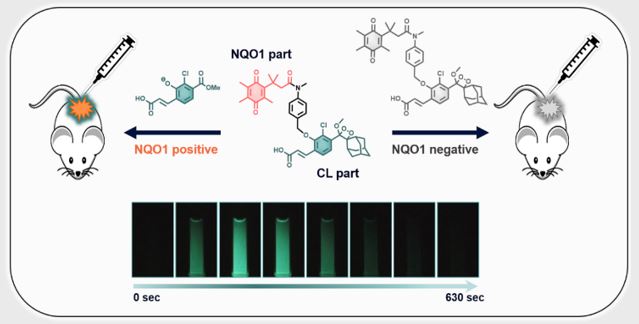Chemiluminescent Probe for the In Vitro and In Vivo Imaging of Cancers Over-Expressing NQO1
| author | Jong Seung Kim |
|---|---|
| Homepage | http://orgchem.korea.ac.kr |
| journal | Angew. Chem. Int. Ed. (in press) |
Activatable (turn-on) probes that permit the rapid, sensitive, selective, and accurate identification of cancer-associated biomarkers can help drive advances in cancer research. Herein, a NAD(P)H:quinone oxidoreductase- 1 (NQO1)-specific chemiluminescent probe 1 is reported that allows the differentiation between cancer subtypes. Probe 1 incorporates an NQO1-specific trimethyl-locked quinone trigger moiety covalently tethered to a phenoxy-dioxetane moiety through a para-aminobenzyl alcohol linker. Bio-reduction of the quinone to the corresponding hydroquinone results in a chemiluminescent signal. As inferred from a combination of in vitro cell culture analyses and in vivo mice studies, the probe is safe, cell permeable, and capable of producing a “turn-on” luminescence response in an NQO1-positive A549 lung cancer model. On this basis, probe 1 can be used to identify cancerous cells and tissues characterized by elevated NQO1 levels.
https://onlinelibrary.wiley.com/doi/full/10.1002/anie.201813032
Articles
-
 Synergistic Effects on Lithium Metal Batteries by Preferential Ionic Interactions...
Synergistic Effects on Lithium Metal Batteries by Preferential Ionic Interactions...
-
 Operando Raman and UV-Vis spectroscopic investigation of the coloring and bleachi...
Operando Raman and UV-Vis spectroscopic investigation of the coloring and bleachi...
-
 Ultrafast intraband Auger process in self-doped colloidal quantum dots
Ultrafast intraband Auger process in self-doped colloidal quantum dots
-
 Two-dimensional electronic spectroscopy of bacteriochlorophyll a with synchronize...
Two-dimensional electronic spectroscopy of bacteriochlorophyll a with synchronize...
-
 Superexchange Coupling-Induced Enhancements of Thermoelectric Performance in Satu...
Superexchange Coupling-Induced Enhancements of Thermoelectric Performance in Satu...
-
 Fluorescent Diagnostic Probes in Neurodegenerative Diseases
Fluorescent Diagnostic Probes in Neurodegenerative Diseases
- An Ethacrynic Acid-Brominaed BODIPY Photosensitizer (EA-BPS) Construct Enhances t...
-
 High Ammonia Uptake of a Metal-Organic Framework Adsorbent in a Wide Pressure Range
High Ammonia Uptake of a Metal-Organic Framework Adsorbent in a Wide Pressure Range
-
 Emerging Porous Materials and their Composites for NH3 Gas Removal
Emerging Porous Materials and their Composites for NH3 Gas Removal
-
 Light-directed trapping of metastable intermediates in a self-assembly process
Light-directed trapping of metastable intermediates in a self-assembly process
-
 Multiply Charged Conjugated Polyelectrolytes as a Multifunctional Inerlayer for E...
Multiply Charged Conjugated Polyelectrolytes as a Multifunctional Inerlayer for E...
-
 Green-, Red-, and Near-Infrared-Emitting Polymer Dot Probes for Simultaneous Mult...
Green-, Red-, and Near-Infrared-Emitting Polymer Dot Probes for Simultaneous Mult...
-
 Intermetallic PtCu Nanoframes as Efficient Oxygen Reduction Electrocatalysts
Intermetallic PtCu Nanoframes as Efficient Oxygen Reduction Electrocatalysts
-
 Pt Dopant: Controlling the IR Oxidation States toward Efficient and Durable Oxyge...
Pt Dopant: Controlling the IR Oxidation States toward Efficient and Durable Oxyge...
-
 Color-Runable Boron-Based Emitters Exhibiting Aggregation-Induced Emission and Th...
Color-Runable Boron-Based Emitters Exhibiting Aggregation-Induced Emission and Th...
-
 Catalytic Nanoframes and Beyond
Catalytic Nanoframes and Beyond
-
 Highly Crystalline Hollow Toroidal Copper Phosphosulfide via Anion Exchange: A Ve...
Highly Crystalline Hollow Toroidal Copper Phosphosulfide via Anion Exchange: A Ve...
-
 Molecular Design of Highly Efficient Heavy-Atom-Free Triplet BODIPY Derivatives f...
Molecular Design of Highly Efficient Heavy-Atom-Free Triplet BODIPY Derivatives f...
-
 Transformation of Colloidal Quantum Dot: From Intraband Transition to Localized S...
Transformation of Colloidal Quantum Dot: From Intraband Transition to Localized S...
-
 Mitochondrial Relocation of a Common Synthetic Antibiotic: A Non-genotoxic Approa...
Mitochondrial Relocation of a Common Synthetic Antibiotic: A Non-genotoxic Approa...
Designed by sketchbooks.co.kr / sketchbook5 board skin
